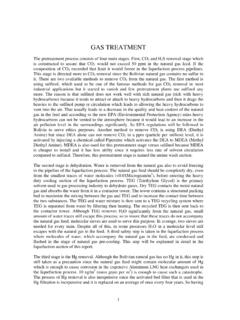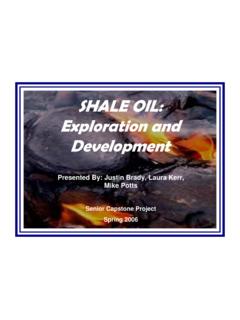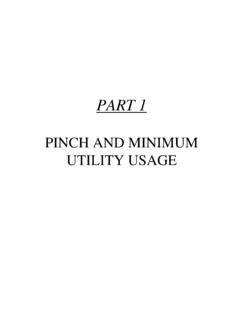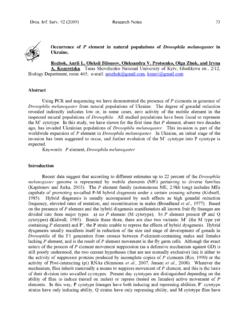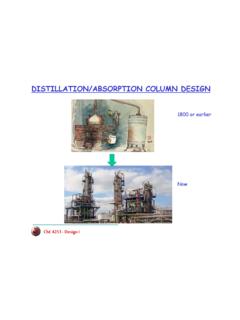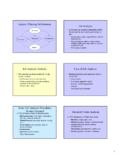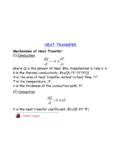Transcription of Three-way ANOVA - The University of Oklahoma
1 1 Three-way ANOVAD ivide and conquerGeneral Guidelines for Dealing with a 3-way ANOVA ABC is significant: Do not interpret the main effects or the 2-way interactions. Divide the 3-way analysis into 2-way analyses. For example, you may conduct a 2-way analysis (AB) at each level of C. Follow up the two-way analyses and interpret them. Of course, you could repeat the procedure for, say, the AC interaction at different levels of ANOVA ABC is NOT significant, but all of the 2-way interactions (AB, AC, & BC) are significant: You may follow up and interpret the two way interactions, but not the main effects. Plot the AB interaction ignoring C to interpret it.
2 You could also compare the means on the AB-table using post-hoc (or planned) comparisons. You may repeat the procedure for the AC and BC ANOVA ABC is not significant AB is not significant AC is not significant BC is significant A is significantYou can follow up interpret the BC interaction and the A main ANOVA ABC is not significant AB is not significant AC is not significant BC is not significant A is significant B is significant C is not significantYou can follow up and interpret the A and B main Measures Designs Simple repeated Measures Design: Uses the same subjects in all conditions. 2 Simple Repeated Measures Design The observations are not independent over conditions.
3 It is an extension of the correlated (or paired) t-test. This analysis is also called a Within DesignSAS Setup for a Simple Repeated Measures Designdatarepeated;input ss y1-y3;cards;1 22 24 1910 18 17 23;proc print; run;proc means;run;proc glm;model y1-y3= / nouni;repeated repfact3; run;Means and Standard 's Greatest 's ' LambdaPr > FDen DFNum DFF ValueValueStatisticManova Test Criteria and Exact F Statistics for the Hypothesis of no repfact EffectH = Type III SSCP Matrix for repfactE = Error SSCP MatrixS=1M=0N=3 Multivariate TestsThe circularity assumption is not needed for the multivariate tests to be (repfact) Pr > FPr > FF ValueMeanSquareType IIISSDFS ourceCircularity Assumption is Met when epsilon is Epsilon3 Epsilon Epsilon is a (sample) measure of how well the circularity assumption has been met.
4 It ranges from 1/dfrep< < our previous example, the range is1/2 < < epsilon is one, the circularity assumption has been met. If epsilon is 1/dfrep, circularity has been violated in a bad on Epsilon If epsilon is not one, the usual univariate F-test must be adjusted. When considering the univariate F-test we have three possibilities for adjusting the degrees of freedom: Usual Conservative AdjustedAdjusting the df s in the Univariate F-tests Usual F-test: use the usual dfs a-1=2; (a-1)(s-1)=2*9=18; df s=2,18 Conservative F-test (assume that =.5) Then the df s are 1 and 9. ,2,18= ,1,9= Epsilon corrected F-tests Compute the sample epsilon and multiplied the dfsby this Test is Best?
5 Multivariate test makes less assumptions but it is not always more powerful. The e-adjusted test is a good alternative and can be more powerful than the multivariate tests. Ordinarily we look at both tests. If both of them are significant, then report the one. Never rely on the usual univariate ANOVAOne Within and One Between Lets say B is the within factor And that A is the between factorsn1+1sn2A2s1sn1A1B4B3B2B1F-test for the Groups by trials (b-1)(s-1)aB*S/A (error for B and B*A)(b-1)(a-1)B*A(b-1)B(n-1)aS/A (error for A)(a-1)AF-testdfSource4 Weight Training Data datawtsmiss; inputsubj program$ s1 s2 s3 s4 s5 s6 s7; datalines.
6 1 CONT 85 85 86 85 87 86 87 2 CONT 80 79 79 78 78 79 78 3 CONT 78 77 77 77 76 76 77 4 CONT 84 84 85 84 83 84 85 5 CONT 80 81 80 80 79 79 80 6 CONT 76 78 77 78 78 77 74 7 CONT 79 79 80 79 80 79 81 8 CONT 76 76 76 75 75 74 74 9 CONT 77 78 78 80 80 81 80 10 CONT 79 79 79 79 77 78 79 SAS Setup for Groups by Trials /* Test of homogeneity of var-cov matrices for the Multivariate tests */ proc discrimpool=test; classprogram; Var s1-s7; run; /* Obtainin the corrected univariate and multivariate tests */ Proc glmdata=wtsmiss; classprogram; models1-s7= program / nouni; repeatedtime 7/printe summary; meansprogram; run;Looking at the Programs /* Running the simple main effect tests on the programs*/ proc glmdata=wtsmiss; classprogram; models1-s7= program; meansprogram /tukey; run.
7 Assessing the Homogeneity AssumptionWithin Covariance Matrix InformationprogramCovarianceMatrix RankNatural Log of theDeterminant of theCovariance Chi-square TestChi-SquareDFPr > Test for the Hypothesis of no Time*program EffectH = Type III SSCP Matrix for time*programE = Error SSCP MatrixS=2M= ValueNum DFDen DFPr > FWilks' 's 's Greatest Effect5 Manova Test Criteria and Exact F Statistics for the Hypothesis of no time EffectH = Type III SSCP Matrix for timeE = Error SSCP MatrixS=1M=2N= ValueNum DFDen DFPr > FWilks' <.0001 Pillai's <. <.0001 Roy's Greatest <.0001 Time EffectGreenhouse-Geisser TestsVariablesDFMauchly'sCriterionChi-SquarePr > ChiSqTransformed <.
8 0001 Orthogonal <.0001 Test of Circularity for the Repeated FactorSourceDFType III SSMean SquareF ValuePr > Variable: time_4 SourceDFType III SSMean SquareF ValuePr > Analysis: The Between EffectSourceDFType III SSMean SquareF ValuePr >FAdj Pr > * (time) Tests: Time & Interaction6 SourceDFType III SSMean SquareF ValuePr > EffectContrast Variable: time_1 vs. Time_7 SourceDFType III SSMean SquareF ValuePr > Variable: time_2 vs. Time_7 SourceDFType III SSMean SquareF ValuePr > III SSMean SquareF ValuePr > Variable: time_377787980818283841234567 cWiRIPlot of MeansWIRIContT7T6T5T4T3T2T1 Repeated FactorBetweenAs/ABBAB*s/A Simple Main Effects in Repeated Measures Designs7 Simple Main Effect with Repeated Factors When going across the repeated factor at a level of the between factor: Use the error term for the repeated factor.
9 When going across the between factor at a level of the within factor: Pool the between and within error ++=


